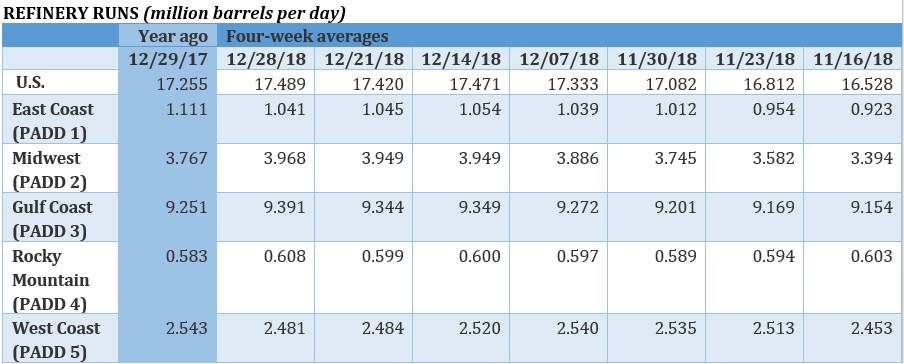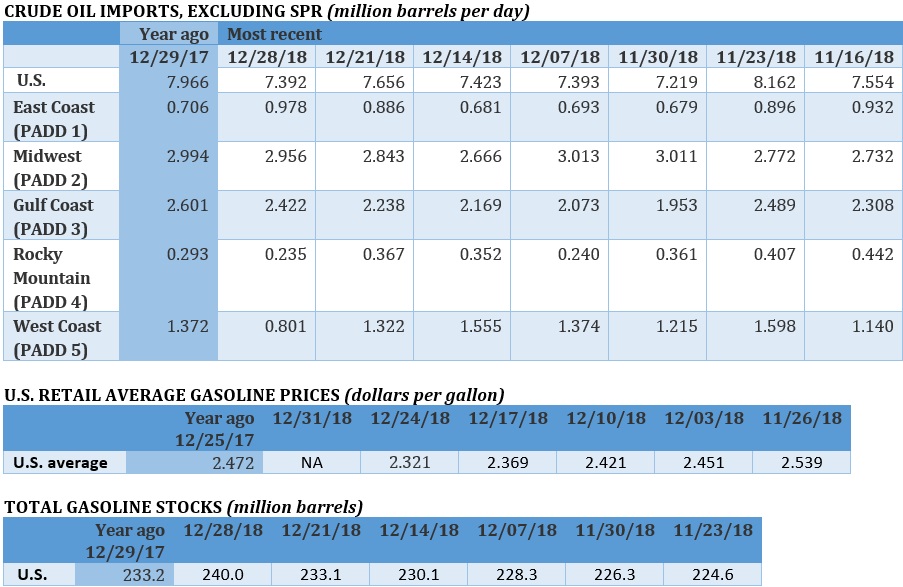Bullish sentiment has returned to oil markets in 2019, with Saudi Arabia cutting production while China and the U.S. look to end the trade war.
(Click to enlarge)
(Click to enlarge)
(Click to enlarge)
(Click to enlarge)
(Click to enlarge)
(Click to enlarge)
(Click to enlarge)
(Click to enlarge)
Friday, January 4th, 2019
Oil prices popped on Friday as signs of a trade thaw emerged and data showed strong OPEC cuts in December.
Oil prices poised for large weekly gain. Brent and WTI are set to close out the week with the largest weekly gain since December 2016. This week, crude benchmarks could gain as much as 10 percent, owing to Saudi production cuts and a broader sense that the oil selloff has gone far enough. “Underpinning this wave of buying is mounting evidence that Saudi Arabia has taken an axe to its oil production,” Stephen Brennock, an analyst at PVM Oil Associates Ltd., told Bloomberg.
Strong U.S. employment data. The U.S. Labor Department reported strong job figures for December, with employers adding an estimated 312,000 jobs for the month, higher than expected. The data suggests the U.S. economy remains in solid shape, even as signs of a global slowdown have continued to mount. The downside of the jobs report is that it undercuts the case for the Federal Reserve to abandon interest rate hikes. It could also embolden the Trump administration to take a harder line in trade talks with China.
U.S.-China trade talks. U.S. and Chinese officials are set to meet on Monday to resume trade talks, and news of the meeting bolstered sentiment in financial markets. The three-month truce in the U.S.-China trade war ends in March, but the tone from officials from both countries has thawed recently. The shakiness in the global economy, which the trade war has contributed to, is also putting pressure on both sides to back away from the brink. “China has a strong desire to have a truce on trade war,” Shi Yinhong, a professor of international relations at Renmin University in Beijing, told the FT. “[T]he probability of the two sides reaching an agreement within the 90 days is growing”.
U.S. shale activity slowed in fourth quarter. The collapse of oil prices in the fourth quarter of 2018 led to a slowdown in the shale patch. The business activity index published by the Federal Reserve Bank of Dallas show that activity decelerated and production growth slowed. The data suggests that the U.S. shale industry was very responsive and sensitive to lower oil prices. The average prediction for year-end WTI prices from oil and gas executives was $59 per barrel.
OPEC production fell in December. OPEC’s oil production fell in December to 32.68 mb/d, down about 460,000 bpd from a month earlier, according to Reuters. It was the largest monthly decline in two years. The reductions came ahead of the OPEC+ deal, which begins this month, and suggests that Saudi Arabia wanted to unilaterally tighten up the market. Saudi Arabia alone slashed output by 400,000 bpd, and Saudi officials said they would cut deeper in January.
U.S. shale production problems. The Wall Street Journal reported that U.S. shale companies have over-hyped the production potential from thousands of shale wells. “Two-thirds of projections made by the fracking companies between 2014 and 2017 in America’s four hottest drilling regions appear to have been overly optimistic, according to the analysis of some 16,000 wells operated by 29 of the biggest producers in oil basins in Texas and North Dakota,” the WSJ wrote. “Collectively, the companies that made projections are on track to pump nearly 10% less oil and gas than they forecast for those areas.” The WSJ calculated that the lower-than-expected production adds up to nearly one billion barrels of oil and gas over 30 years, worth more than $30 billion at current prices.
Libya’s Sharara field sees more trouble. Libya’s largest oil field, the Sharara field, was hit with more bad news this week. “An inspection team reported the theft of key operational equipment, including transformers and cables from several wells. The incident will reduce Sharara's output by approximately 8,500 barrels per day even after the main system restarts operations,” Libya’s National Oil Corp. said in a statement. The Sharara field, which has typically produced in excess of 300,000 bpd, was temporarily shut down last month. “We are very concerned these attacks are not simple robberies but are part of a systematic attempt to destroy the Sharara system,” NOC chairman Mustafa Sanalla said.
Offshore drilling plans delayed on government shutdown. The U.S. Interior Department delayed the release of a proposed plan for offshore oil and gas leasing sales from 2019 through 2024 due to the ongoing government shutdown, according to S&P Global Platts. The plan was supposed to be released in mid-January but is now likely delayed.
Oil tanks in Permian caught fire. A series of oil tanks caught fire near a Noble Energy (NYSE: NBL) well site in the Permian in the early hours on January 2. The well was shut down and no injuries were reported.
Michigan to review Line 5 pipeline plans. The eleventh-hour deal between Enbridge (NYSE: ENB) and Michigan’s outgoing Republican governor is now being scrutinized by the new Democratic Governor and the state’s Attorney General. The plan calls for Enbridge to build a new line next to the aging Line 5 system, which is over sixty years old. Environmental groups and native tribes have vociferously opposed the plan, which they argue could spoil the Mackinac Straights. Line 5 carries crude oil and natural gas liquids from Canada, across Michigan, to a major petrochemical hub in Sarnia, Ontario.











